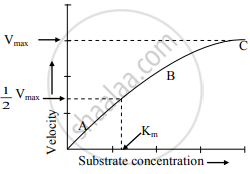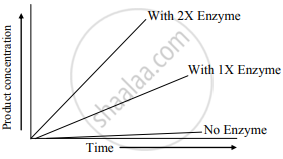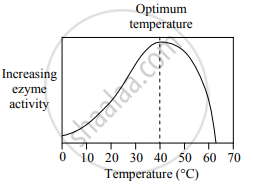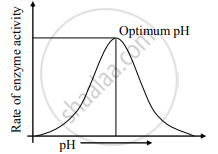Advertisements
Advertisements
Question
Long answer question.
Describe the factors affecting enzyme action.
Solution
The factors affecting enzyme activity are as follows:
- Concentration of substrate:
- An increase in the substrate concentration gradually increases the velocity of enzyme activity within the limited range of substrate levels.
- A rectangular hyperbola is obtained when velocity is plotted against the substrate concentration.
- Three distinct phases (A, B and C) of the reaction are observed in the graph.
Where V = Measured velocity, Vmax = Maximum velocity, S = Substrate concentration, Km = Michaelis-Menten constant. - Km or the Michaelis-Menten constant is defined as the substrate concentration (expressed in moles/lit) to produce half of the maximum velocity in an enzyme-catalyzed reaction.
- It indicates that half of the enzyme molecules (i.e. 50%) are bound with the substrate molecules when the substrate concentration equals the Km value.
- Km value is a constant and a characteristic feature of a given enzyme.
- It is a representative for measuring the strength of ES complex.
- A low Km value indicates a strong affinity between enzyme and substrate, whereas a high Km value reflects a weak affinity between them.
- For majority of enzymes, the Km values are in the range of 10-5 to 10-2 moles.

- Enzyme Concentration:
- The rate of an enzymatic reaction is directly proportional to the concentration of the substrate.
- The rate of reaction is also directly proportional to the square root of the concentration of enzymes.
- It means that the rate of reaction also increases with the increasing concentration of enzyme and the rate of reaction can also decrease by decreasing the concentration of the enzyme.

Effect of enzyme concentration
- Temperature:
- The temperature at which the enzymes show maximum activity is called Optimum temperature.
- The rate of a chemical reaction is increased by a rise in temperature but this is true only over a limited range of temperature.
- Enzymes rapidly denature at a temperature above 40°C.
- The activity of enzymes is reduced at low temperatures.
- The enzymatic reaction occurs best at or around 37°C which is the average normal body temperature in homeotherms.

Effect of temperature on enzyme activity
- Effect of pH:
- The pH at which an enzyme catalyzes the reaction at the maximum rate is known as optimum pH.
- The enzyme cannot perform its function beyond the range of its pH value.

Effect of pH on enzyme activity
- Other substances:
- The enzyme action is also increased or decreased in the presence of some other substances such as coenzymes, activators, and inhibitors.
- Most of the enzymes are a combination of a co-enzyme and an apo-enzyme.
- Activators are the inorganic substances which increase the enzyme activity.
- The inhibitor is the substance that reduces the enzyme activity.
APPEARS IN
RELATED QUESTIONS
Answer the following question.
Enlist the examples of simple protein and add their significance.
Answer the following question.
Explain the induced fit model for the mode of enzyme action.
Match the following items given in column I and II.
| Column I | Column II | ||
| i. | RNA | a. | Induced fit model |
| ii. | Yam plant | b. | Flax seeds |
| iii. | Koshland | c. | Hydrolase |
| iv. | Omega-3-fatty acid | d. | Uracil |
| v. | Sucrase | e. | Anti-fertility pills |
Long answer question.
Describe classes of proteins with their importance.
Long answer question.
Explain the properties of an enzyme?
Long answer question.
Describe the models for enzyme actions.
Long answer question.
What are the types of RNA? Mention the role of each class of RNA.
Long answer question.
How metabolic pool is formed in the cell.
Name the form in which carbohydrate is transported in a plant.
Insulin is a/an
